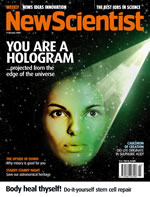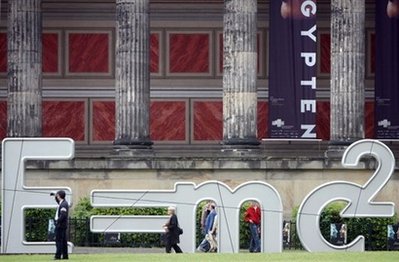Topic: SCIENCE - on February 12, 2009 at 1:34:00 PM CET
Vatican buries the hatchet with Charles Darwin
The Vatican has admitted that Charles Darwin was on the right track when he claimed that Man descended from apes.
A leading official declared yesterday that Darwin’s theory of evolution was compatible with Christian faith, and could even be traced to St Augustine and St Thomas Aquinas. “In fact, what we mean by evolution is the world as created by God,” said Archbishop Gianfranco Ravasi, head of the Pontifical Council for Culture. The Vatican also dealt the final blow to speculation that Pope Benedict XVI might be prepared to endorse the theory of Intelligent Design, whose advocates credit a “higher power” for the complexities of life.
timesonline.co.uk At 200, Darwin Evolves Beyond Evolution 200. Geburtstag von Charles Darwin
... Link (0 comments) ... Comment
Topic: SCIENCE - on February 5, 2009 at 12:57:00 PM CET
Archäologen finden 1,8 Millionen Jahre alte Steinwerkzeuge
Hat Homo erectus mit ihnen einmal Holz geschlagen? In Malaysia haben Archäologen uralte Handäxte entdeckt, die unsere menschlichen Vorfahren offenbar vor 1,8 Millionen Jahren benutzt haben. Nun müssen die Forscher nur noch die Knochen zu den Werkzeugen finden.
... Link (0 comments) ... Comment
Topic: SCIENCE - on January 30, 2009 at 1:07:00 PM CET
Scientists Turn Tequila into Diamonds
Whoever thought that science was a dry subject might change their mind after learning about a new discovery in which tequila is turned into diamonds. A team of Mexican scientists found that the heated vapor from 80-proof (40% alcohol) tequila blanco, when deposited on a silicon or stainless steel substrate, can form diamond films.
... Link (0 comments) ... Comment
Topic: SCIENCE - on January 23, 2009 at 1:13:00 PM CET
Sind Sie Darwinist?
Evolution, Mutation, Selektion - in aller Welt wird Charles Darwins 200. Geburtstag gefeiert. Verstehen Sie, warum? Im SPIEGEL-ONLINE-Quiz werden Sie Evolutionstheoretiker.
... Link (0 comments) ... Comment
Topic: SCIENCE - on January 17, 2009 at 11:07:00 AM CET
Our world may be a giant hologram
The story begins at the German experiment GEO600, a laser inteferometer looking for gravity waves. For years, researchers there have been locating and eliminating sources of interference and noise from the experiment (they have not yet seen a gravity wave). For months they have been puzzling over a source of noise they could not explain. Then Craig Hogan, a Fermilab physicist, approached them with a possible answer: that GEO600 may have stumbled upon a fundamental limit where space-time stops behaving like a smooth continuum and instead dissolves into "grains." The "holographic principle" suggests that the universe at small scales would be "blurry," its smallest features far larger than Planck scale, and possibly accessible to current technology such as the GEO600. The holographic principle, if borne out, could help distinguish among competing theories of quantum gravity, but "We think it's at least a year too early to get excited," the lead GEO600 scientist said.

... Link (0 comments) ... Comment
Topic: SCIENCE - on December 7, 2008 at 1:35:05 PM CET
Is Einstein the Last Great Genius?
Major breakthroughs in science have historically been the province of individuals, not institutes. Galileo and Copernicus, Edison and Einstein, toiling away in lonely labs or pondering the cosmos in private studies.
But in recent decades - especially since the Soviet success in launching the Sputnik satellite in 1957 - the trend has been to create massive institutions that foster more collaboration and garner big chunks of funding.

... Link (0 comments) ... Comment
Topic: SCIENCE - on October 18, 2008 at 1:32:00 PM CEST
Reading This Will Change Your Brain
Is technology changing our brains? A new study by UCLA neuroscientist Gary Small adds to a growing body of research that says it is. And according to Small's new book, "iBRAIN: Surviving the Technological Alteration of the Modern Mind," a dramatic shift in how we gather information and communicate with one another has touched off an era of rapid evolution that may ultimately change the human brain as we know it. "Perhaps not since early man first discovered how to use a tool has the human brain been affected so quickly and so dramatically," he writes. "As the brain evolves and shifts its focus towards new technological skills, it drifts away from fundamental social skills."
... Link (0 comments) ... Comment
Topic: SCIENCE - on October 8, 2008 at 10:11:00 AM CEST
Dear! Change the Lightbulb, I Lost the Internet!
The US government is funding research into using next-generation LED lighting as data network access points. Room or street lamps would link with devices using visible light, carrying data beyond over existing power lines.
"This is a unique opportunity to create a transcendent technology that not only enables energy-efficient lighting, but also creates the next generation of secure wireless communications," said Prof Thomas Little of Boston Uni.

... Link (0 comments) ... Comment
Topic: SCIENCE - on October 6, 2008 at 10:12:00 AM CEST
Ancient Peru Pyramid Spotted by Satellite
A new remote sensing technology has peeled away layers of mud and rock near Peru's Cahuachi desert to reveal an ancient adobe pyramid, Italian researchers announced on Friday at a satellite imagery conference in Rome.
Nicola Masini and Rosa Lasaponara of Italy's National Research Council (CNR) discovered the pyramid by analyzing images from the satellite Quickbird, which they used to penetrate the Peruvian soil.
... Link (0 comments) ... Comment
Topic: SCIENCE - on October 4, 2008 at 11:32:00 AM CEST
CERN’s New Super Computer Links Scientists Worldwide
CERN, the world’s largest particle physics lab that created the Worldwide Web, exhibited its newest development on Friday: a computer network allowing some 7,000 scientists in 33 countries to connect and share data and processing power.
... Link (0 comments) ... Comment
Topic: SCIENCE - on October 1, 2008 at 11:50:00 AM CEST
"Hubble" sendet keine Daten mehr
Sorge um den Star der Astronomie: Das "Hubble"-Weltraumteleskop hat plötzlich aufgehört, Daten zur Erde zu funken. Das Problem ist offenbar so ernst, dass die Nasa die für Mitte Oktober geplante Reparaturmission aufs nächste Jahr verschoben hat.
Möglicherweise hatte die Nasa diesmal sogar Glück im Unglück. Ursprünglich sollte die Raumfähre "Atlantis" am 10. Oktober zum "Hubble"-Teleskop fliegen, um dringend benötigte Wartungsarbeiten durchzuführen. Dann wurde der Termin auf den 14. Oktober verschoben. Nun hat sich ein neues, unerwartetes Problem ergeben: Seit der Nacht zum Sonntag schickt das Weltraumobservatorium keine Daten mehr zur Erde. Im günstigsten Fall kann sich die Nasa vor dem Reparaturflug auf die neue Situation einstellen.
... Link (0 comments) ... Comment
Topic: SCIENCE - on October 1, 2008 at 11:44:00 AM CEST
The amazing dirt-powered lamp
Microbial fuel cells, which use electrodes in dirt to power a small motor, have long been more or less a laboratory curiosity. Because they generate such a small amount of power, developing them to charge devices would not be practical in places where electricity is readily available. However, Lebônê Solutions, a startup based in Cambridge, MA, aims to use microbial fuel cells to provide power to Africans who are off the grid. In some parts of Africa, a small amount of energy is enough for a few hours of lamp light in the evening, or for powering the ubiquitous cell phones--something that some residents will walk five hours to a generator to do, says Aviva Presser, a cofounder of Lebônê. The company is made up largely of Harvard University alumni and current Harvard students originally from African countries.

... Link (0 comments) ... Comment










